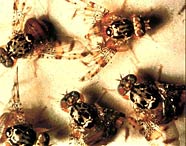Fruit Flies
 The Mediterranean fruit fly, Oriental fruit fly, melon fly and Malaysian fruit fly represent the fruit fly complex in Hawaii. U.S. Department of Agriculture–Agricultural Research Services, is conducting a fruit fly suppression study in Hawaii. The program has demonstrated that fruit fly populations can be substantially suppressed in an integrate pest management program involving field sanitation, chemical use and the release of sterile fruit flies. The success of the USDA, ARS suppression study in Hawaii is reason for optimism that fruit fly eradication may be a possibility for Hawaii in the foreseeable future. All four would have to be eradicated for Hawaii to be declared fruit fly free and the above quarantine lifted.
The Mediterranean fruit fly, Oriental fruit fly, melon fly and Malaysian fruit fly represent the fruit fly complex in Hawaii. U.S. Department of Agriculture–Agricultural Research Services, is conducting a fruit fly suppression study in Hawaii. The program has demonstrated that fruit fly populations can be substantially suppressed in an integrate pest management program involving field sanitation, chemical use and the release of sterile fruit flies. The success of the USDA, ARS suppression study in Hawaii is reason for optimism that fruit fly eradication may be a possibility for Hawaii in the foreseeable future. All four would have to be eradicated for Hawaii to be declared fruit fly free and the above quarantine lifted.
The ARS study has demonstrated that fruit fly levels (melon, oriental and Mediterranean) can be sharply reduced using Spinosad bait to reduce both male and female flies; field sanitation to reduce populations in general; and male annihilation with methyl eugenol (Oriental), cue lure (Melon) and Biolure (Medfly), to further drop fly levels. The study will incorporate the release of parasitoids that attack either the egg or larvae of the fruit flies in fruit and the release of sterile males. Eradication will require the release of sterile males for medfly, melon and Malaysian for the final kill. New technologies, in particular, safer pesticides as Spinosad, make fruit fly eradication in Hawaii (Tephritid species) a more attainable goal today. Eradication will require the use of substantial quantities of other toxicants in combination with fruit fly attractants in a male fruit fly annihilation program. Additional funding is needed to begin a feasibility study for the eradication of fruit flies in Hawaii, to conduct the necessary EA and EIS and to fund additional research as needed to evaluate potential environmental impacts of the technologies.
Hawaii is the only state under a full federal fruit fly quarantine; the presence of fruit flies in Hawaii is a threat to U.S. mainland agriculture and a major bottleneck to the expansion of diversified agriculture in the state, for local as well as export sales.
Statewide: All four fruit flies are established on all islands in the State.